
19 Days Qinghai-Tibet Cycling Tour from Golmud to Lhasa
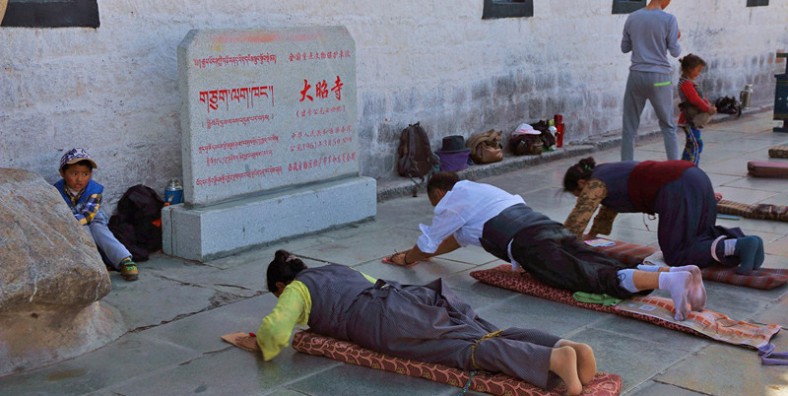
Tour Overview
Ignite your spirit and enrich your soul on this Qinghai-Tibet Plateau Cycling Adventure. Cycling from Golmud in Qinghai to Lhasa in Tibet, we whisk through the vast steppes of...
Code of Tour: YCT0000000539
Length of Travel: 19 Day
Destinations of Tour: Golmud - Kunlun Mountain - Wudaoliang - Tuotuo River - Amdo - Nagqu - Namtso - Yangpachen - Lhasa
Departure City: Xining
Price of Tour: Request
Type of Tour:
Features of Tour: Nature Culture Landscape Cycling
Ignite your spirit and enrich your soul on this Qinghai-Tibet Plateau Cycling Adventure. Cycling from Golmud in Qinghai to Lhasa in Tibet, we whisk through the vast steppes of Hoh Xil Nature Reserve and the prairie of Qiangtang Grassland; overcome the mountain passes of Kunlun Mountain, Tanggula Mountain; admire the pure natural landscapes of snow-capped mountains, alpine pastures and lakes. Prepare for a biking journey as rich in culture as it is in challenge. By the time we reach Lhasa, we will have witnessed the majesty of the Potala Palace and experience the unique Tibetan Buddhism culture.
Highlights:
- Cycling through the Qinghai-Tibet Plateau from Xining to Lhasa.
- Riding to traverse Kunlun Mountain, Tanggula Mountain and Hoh Xil Nature Reserve.
- Meet tranquil lakes, shimmering rivers, Tibetan villages and rare animals on your way.
- Experience Tibetan Buddhism in significant monasteries along your way and in Lhasa city.
Brief Itinerary
- Day 1: Xining Arrival
- Day 2: Xining-Chaka
- Day 3: Chaka-Golmud
- Day 4: Golmud-Nachitai County
- Day 5: Nachitai County-Xidatan
- Day 6: Xidatan-Suonandajie Protection Station
- Day 7: Suonandajie Protection Station-Wudaoliang
- Day 8: Wudaoliang-Tuotuo River Town
- Day 9: Tuotuo River Town-Yanshiping County
- Day 10: Yanshiping County-Toudaoban
- Day 11: Toudaoban-Amdo County
- Day 12: Amdo County-Nagqu
- Day 13: Naqu-Gulu Town
- Day 14: Gulu Town-Damxung-Namtso Lake
- Day 15: Namtso Lake-Damxung-Yangpachen
- Day 16: Yangpachen-Lhasa
- Day 17: Lhasa
- Day 18: Lhasa
- Day 19: Lhasa Departure
Google Map
Detailed Itinerary
Day 1 Arrival in Xining
Sightseeing and Activities:arrive in Xining
Accommodation:Xining
Meals:None
After welcoming you at the Airport, a China Adventures representative will transfer you to a comfortable hotel in the city.
Day 2 Xining – Chaka
Sightseeing and Activities:Kumbum Monastery (Ta’er Si)
Accommodation:Chaka Guest House
Meals:Breakfast, Lunch
After breakfast at hotel, we’ll depart for a drive to Chaka County with a sightseeing stop at Kumbum Monastery (Ta’er Si). Located 26km south of Xining city, the sacred monastery is one of the most popular sights and the religious activity center in Xining area. Built in 1577 on hallowed ground – the birthplace of Tsongkhapa, it’s of enormous historical significance. The artwork and architecture remain impressive after over 400 years. Afterwards, get back to the vehicle and transfer to Chaka. Stay overnight in a guesthouse.
Day 3 Chaka – Golmud (2,815m)
Sightseeing and Activities: Chaka Salt Lake
Accommodation:Golmud
Meals:Breakfast, Lunch
This morning, we’ll transfer to visit Chaka Salt Lake before driving to Golmud. Located in the Qaidam Basin, the Chaka (meaning the sea of salt in Mongolian language) Salt Lake covers an area of 105 square kilometers, and it is a typical chloride salt lake. The highlight of the lake is its reflective surface, which mirrors the passing clouds, the distant mountains and the nomad´s tents and herds. We’ll take tourist train to the salt farm, watching the mining of salt, and admiring various salt crystals in the shape of pearls, corals, snowflakes, and mushrooms. After that, continue driving to Golmud and check in at a hotel.
Day 4 Golmud – Nachitai County (3,600m) (cycle 93km)
Sightseeing and Activities:Cycle from Golmud to Nachitai County
Accommodation:Nachitai
Meals:Breakfast, Lunch
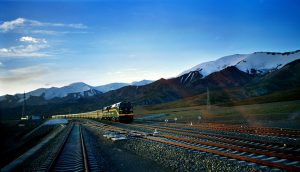
Start our cycling adventure today! It is a solid 13 kilometers before we leave the city limits. Out of Golmud, we start riding south on the Qinghai-Tibet Highway (also National Highway 109). Thus far, the houses disappear and we find ourselves in the desert. Some kilometers later we’ll pass through a gate: ‘God of Mountains’, read the left pillar, while the right one announces the Kunlun Range. This range we have to conquer in the next few days, climbing from 2,800 meters to the 4,767-meter high Kunlun Mountain Pass, before we will drop onto the Tibetan Plateau. It is almost gently uphill terrain all the way. After reaching Nachitai, we may go to visit the famous Kunlun Castalia and feel refreshed with its cool water. Stay overnight in a guesthouse.
Tip: The climate on the Qinghai-Tibetan Plateau is dramatic and the sudden heavy rain will come out unexpectedly. When the altitude increases, it may even snow. So you need to prepare warm clothes, shoes and rainproof.
Day 5 Nachitai County – Xidatan (4,100m) (cycle 38km)
Sightseeing and Activities:Cycle from Nachitai to Xidatan
Accommodation:Xidatan
Meals:Breakfast, Lunch
Today we just cycle 38 km to Xidatan, thus we’ll have some time to rest and acclimatize before continuing onward up the Tibetan plateau. En route, we can’t help admiring this world famous project when we see the up to 50 meters bridge –Sanchahe Bridge, which is the highest bridge along Qinghai-Tibet railway. As Xidatan approaching, we’ll be greeted by the spectacular snow mountains. Stay overnight in a guesthouse.
Day 6 Xidatan – Kunlun Mountain Pass (4,767m) – Suonandajie Protection Station (4,479m) (cycle 88km)
Sightseeing and Activities:Cycle from Xidatan to Suonandajie Protection Station
Accommodation:Suonandajie Protection Station
Meals:Breakfast, Lunch
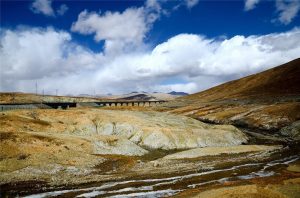
We rise at the crack of dawn to watch the magnificent sunrise over the 6178m Yuzhu Peak, the highest peak of the eastern Kunlun Mountains. When the first streak of sunlight shines on the top of the snow mountain, it wakes up and wears its golden cloth. Then, it’s back on the bikes for a long gentle uphill towards the first pass on the Qinghai-Tibet Highway, Kunlun Mountain Pass. We may see some rare animals leaping and skipping on the snow and grassland. After the pass, we’ll cycle along the eastern boundary of the Hoh Xil (or Kekexili) National Nature Reserve. With some luck, we may spot Tibetan antelopes and other wild animals. An easy downhill will takes us to reach Suonandajie Protection Station via Budongquan (Unfrozen Spring). Stay overnight in the protection station or tents.
Day 7 Suonandajie Protection Station – Wudaoliang (4,621m) (cycle 55km)
Sightseeing and Activities:Cycle from Suonandajie Protection Station to Wudaoliang
Accommodation:Wudaoliang
Meals:Breakfast, Lunch
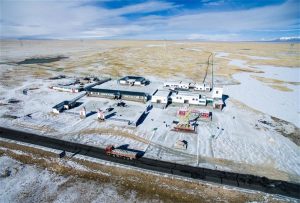
Depart from Suonandajie, we’ll gallop freely on the beautiful Hoh Xil prairie under the clear blue sky dotted with some white clouds. A few wild yaks are chewing and gazing on us in a distance. Some purple flowers are sparkling against the backdrop of the green prairie. What we need to do is to indulge ourselves in the pure nature. If you come in June or September, you may have a chance to witness the spectacular sight of thousands of Tibetan antelopes migration through Chuma’er River Bridge. After climbing a hill and pedaling through a bumpy frozen ground, we’ll reach Wudaoliang where we soon notice to be back again in a real city, because we can find market, restaurant and guesthouses. Have a good rest in a guesthouse.
Tip: Even not at a very high altitude, Wudaoliang is a place that easily causes altitude sickness due to the strong wind, thin air and awful weather. So it is suggested to have a good rest, drink more water and keep warm.
Day 8 Wudaoliang – Tuotuo River Town (4,543m) (cycle 147km or vehicle support)
Sightseeing and Activities:Cycle from Wudaoliang to Tuotuo River Town
Accommodation:Tuotuo River Town
Meals:Breakfast, Lunch
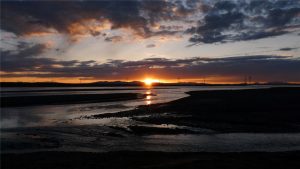
We start with a breakfast and then we jump on our bikes, cycling along the uphill and downhill road for about 70km to reach Fenghuo (means Wind and Fire) Mountain Pass. The pass lives up to its name with strong wind all year round and the bare mountain is as red as raging fire under the bright sunshine. After the pass, the Qinghai-Tibet Railway will come into our sights. If we are lucky not to encounter contrary wind, this afternoon is mostly spent on a long easy descent into Tuotuo River Town. This county is the largest one along Qinghai-Tibet Highway in Qinghai part; so it is a good place for us to restock. If arrive early, we may transfer to visit the source of the Yangtze River. Stay overnight in a guesthouse.
Day 9 Tuotuo River County – Yanshiping Town (4,712m) (cycle 90km)
Sightseeing and Activities:Cycle from Tuotuo River County to Yanshiping Town
Accommodation:Yanshiping Town
Meals:Breakfast, Lunch

Get up early in the morning, this way we can be lucky enough to nourish our aching body with the breath-taking sunrise which dances over the horizon in Tuotuo River. Out of the county, we need to tackle an 18km ascent up to Kaixin (Happy) Ridge. Of course! We should be happy for a long flat downhill road is waiting for us. The road stretches in a valley, offering beautiful scenery. Some Tibetan antelopes and wild donkeys appear in front of our cameras. Accompanied by the views of mountain and stream all the way, we’ll be surprised to find Yanshiping greeting us with the colorful prayer flags. The strong flavor of the Tibetan implies that we are near to Tibet. Stay overnight in a guesthouse.
Day 10 Yanshiping County – Tanggula Mountain Pass (5,231m) – Toudaoban (5,100m) (cycle 122km or vehicle sup
Sightseeing and Activities:Cycle from Yanshiping Town to Tuodaoban
Accommodation:Tuodaoban
Meals:Breakfast, Lunch
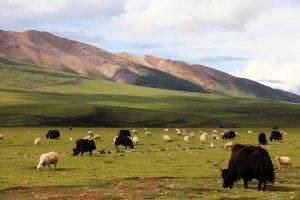
We’ll refuel this morning with a breakfast and then head out on an early cycling to conquer the highest point of the Qinghai-Tibet Highway, Tanggula Mountain Pass at 5,231m. It is a big challenge to tackle a 47 km uphill stretch to the top of the pass, especially under the situation of thin air and atrocious weather. Tanggula Mountain Pass is a natural boundary between Qinghai and Tibet. After this pass, the dramatically different scenery hints us we are now in Tibet. The vast green Changtang Plateau welcomes us with open arms. The snow-capped mountains show its purity and elegance, and empower us to carry on pedaling. A long downhill takes us to reach today’s destination, Toudaoban. Stay overnight in the service station or camping.
Day 11 Toudaoban – Small Tanggula Pass (5,010m) – Amdo County (4,706m) (cycle 78km)
Sightseeing and Activities:Cycle from Tuodaoban to Amdo County
Accommodation:Amdo County
Meals:Breakfast, Lunch
Following a short descent, we need to handle a 28km ascent to reach Small Tanggula Pass at an elevation of 5,010m. This pass is the gateway to get onto Qiangtang Plateau hemmed on both sides by snow mountains. The blue sky, snow mantled mountains and green grassland together depict a picture of heaven. Then we’ll be paid with a very long downhill path twisting in the valley dotted with some Tibet villages. Have a relax in a hostel at Amduo County.
Day 12 Amdo County – Shengeligong Mountain Pass (4,881m) – Nagqu (4,514m) (cycle 138km or vehicle support)
Sightseeing and Activities:Cycle from Amdo to Naqu
Accommodation:Naqu
Meals:Breakfast, Lunch
Today we tackle the hardest, steepest climb of our adventure. The challenge after breakfast is 7 km cycling along the steep & winding mountain road to Shengeligong Mountain pass, leading us to an altitude of 4,881 m. We’ll be disappointed to find that the triumph over the pass is not followed by a long descent but another several big slopes. After the test of our will and energy, we’ll finally start the downhill journey to Nagqu, which is the biggest and best stopover place out of Golmud. In this county, we’ll be encircled by distinct local flavor: Tibetan people, prayer flags, Tibet butter tea, highland barley wine…Have a good rest in a hostel at Nagqu.
Day 13 Nagqu – Gulu Town (4,702m) (cycle 91km)
Sightseeing and Activities:Cycle from Naqu to Gulu Town
Accommodation:Gulu Town
Meals:Breakfast, Lunch
We’ll first have breakfast and then embark on an exciting cycling journey. Today’s road condition is quite good, just a little gentle uphill. Along the way, we’ll be empowered by the beautiful scenery: the cerulean sky, a vast carpet of green grass, flocks of sheep and yaks. If time is sufficient, we could stop in Gulu Town for one more day to have a detour to Droma Valley, mother of holy Lake Namtso. Overnight in a guesthouse at Gulu Town.
Day 14 Gulu Town – Damxung (4,307m) (cycle 74km), then drive to Lake Namtso
Sightseeing and Activities:Cycle from Gulu to Damxung, drive to visit Namtso Lake
Accommodation:Lake Shore
Meals:Breakfast, Lunch
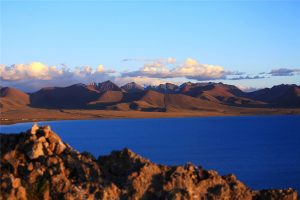
Today continue picturesque ride to Damxung. After a rest in Damxung, China Adventures support vehicle will transfer us to visit the holy Namtso Lake (4718m). Namtso means ‘the heavenly lake’ in Tibetan. It has lain at the foot of the Nyainqêntanglha Snow Mountain for over 70 million years. It is one of the three saint lakes of Tibet, covered with a veiling of mystery and sanctity. Vast grassland spreads around the lake and make the Namtso Lake looks more charming together with the blue sky and white clouds. In a sunny day, the crystal waters of Namtso Lake and the snow mantled mount radiate with each other. All the breath-taking sights will drive our fatigue out and make us relaxed and joyful. The day’s wonderful ending is the glory of sunset over the lake. Stay in a guesthouse or resort tents by the lake.
Day 15 Drive back to Damxung, continue riding to Yangpachen (4,284m) (cycle 75km)
Sightseeing and Activities:Cycle from Damxung to Yangpachen
Accommodation:Yangpachen
Meals:Breakfast, Lunch
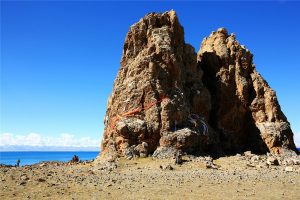
Wake up early to enjoy the clear morning by the lake and the stunning view of the sunrise. If time permits, we also can hike along the lake shore to Tashi Dor Island to explore the meditation caves. After the sightseeing, we’ll be transferred back to Damxung and continue riding to Yangpachen. Out of Damxung, the distant snow-capped Nyainqêntanglha will come into our sight and drive us to go forward. We ride up the trail dotted with green grass and clean current, until reaching the Nyainqêntanglha Pass (4,620m) with panoramic views of our dramatic surroundings. Another big climb is waiting for us, Duonala Mountain Pass, leading us to the altitude of 4,629m. By now, we should cheer for conquering all tough climbs along the Qinghai-Tibet Highway. Then, a long descent leads us to reach Yangpachen, unique for geothermic hot spring. We can go to enjoy a comfortable bath in hot spring. Stay overnight in a guesthouse or tents
Day 16 Yangpachen – Lhasa (3,650m) (cycle 78km)
Sightseeing and Activities:Cycle from Yangpachen to Lhasa
Accommodation:Lhasa
Meals:Breakfast, Lunch
We’ll first have breakfast and then embark on a brilliant full day’s descent to our final destination, Lhasa. The paved road runs through Duilong Valley, flanked by rolling green hills and dotted with some Tibetan villages. A final 10 km boulevard leads us to the holy city at the roof of the world, Lhasa. Here we check into a hotel for a well-deserved shower and a big meal.
Day 17 Lhasa
Sightseeing and Activities:Potala Palace, Jokhang Temple, Barkhor Street
Accommodation:Lhasa
Meals:Breakfast, Lunch
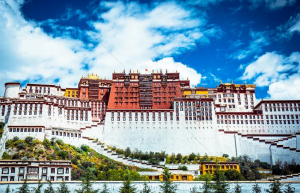
First a wholesome and hearty breakfast and then we’re off for a full day sightseeing. Firstly, go to admire the majesty of the Potala Palace. Known as “a pearl on the ridge of the world”, the Potala Palace is world famous for its outstanding layout, construction, craftwork, painting and sculpture. It reaches the height up to 110 meters with thirteen floors from the mountain foot until the top and with golden roof shinning in the sun. We’ll see the jeweled and golden burial chortens (stupa Tombs) of past Dalai Lamas, and tremendous number of Buddhist frescoes, thangkas, combinations of mandala, etc.
In the afternoon, experience the Tibetan Buddhism culture in the Jokhang Temple. It, constructed 1300 years ago, has been the spiritual center of Tibet and the ultimate pilgrimage destination for Tibetan Buddhists. Finally, take a leisure pilgrim circuit on Barkor Street, a very ancient round street surrounding the Jokhang Temple. Spiritual souvenirs and pilgrim accessories line.
Day 18 Lhasa
Sightseeing and Activities:Norbulingka, Drepung Monastery, Sera Monastery
Accommodation:Lhasa
Meals:Breakfast, Lunch
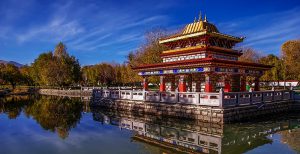
Continue the wonderful sightseeing in Tibet. This morning we’ll depart for a drive to Norbulingka Park. Norbulingka, mea ning ‘Treasure Park’ in Tibetan, is the biggest man-made garden in Tibet. Constructed in the 1740s, it was used as the summer palace for successive Lamas. It both reflects the ethnical, religious features of the Tibetan people and embodies the architecture style of inland China. Afterwards, we’ll come to Drepung Monastery, which was once Tibet’s largest and most influential monastery, with over 10,000 monks. It is especially known as the site of the annual Shoton Festival, with its dramatic unfurling of a giant thangka painting on the hillside. In the end, visit Sera Monastery, which is unique for ‘Buddhism Scriptures Debating’. We will experience how the Lamas study the Buddhism scriptures and also touch the real life of local Tibetan people.
Day 19 Departure from Lhasa
Sightseeing and Activities:departure from Lhasa
Accommodation:None
Meals:Breakfast
It is the end of your exciting Qingtai-Tibet Highway cycling adventure from Xining to Lhasa. The guide and driver from China Adventures will escort you to the airport for your homebound flight.
Recommended Hotels
| Destination | 5 Star | 4 Star | 3 Star |
| Xining | Wanda Realm Xining | Mehood Hotel (Xining Haihu New District) | Home Inn Plus |
| Golmud | Swisstouches Hotel Qinghai | Exquisite Hotel | Kunhai Hotel |
| Nachitai | / | / | / |
| Amdo | / | / | Naqu Tianci Business Hotel |
| Naqu | Yuanfeng Hotel | Zangbei Yingbin Hotel | San Yi Business Hotel |
| Yangpachen | / | / | Yangbajing Lantian Hot Spring Hotel |
| Lhasa | Luxury St. Regis Lhasa Resort | Lhasa Gang Gyan Hotel | Lhasa Xiongbala Hotel |
Service Included:
-
Tibet travel permit and all other necessary permits to Tibet;
-
All entrance ticket fees for all tourist sites listed in the itinerary;
-
Personal knowledgeable English-speaking Tibetan local tour guide;
-
Personal comfortable, clean and safe vehicle with reliable Tibetan local driver; vehicle ranging from 4WD land cruiser to minibus depending on your group size;
-
All lodging listed in the itinerary; it’s your decision about the accommodation class: luxury 5-star international hotel, comfortable 4-star hotel, economic 3-star hotel or budget hostel, guesthouse or tent. Please tell us your accommodation preference when submitting the enquiry; we will arrange the best-value hotels for you.
-
Domestic flight/train tickets listed in the itinerary;
-
All meals listed in the above itinerary;
-
Tourist accident/casualty insurance;
-
First aid kit;
Service Excluded:
-
Tibet travel permit and all other necessary permits to Tibet;
-
All entrance ticket fees for all tourist sites listed in the itinerary;
-
Personal knowledgeable English-speaking Tibetan local tour guide;
-
Personal comfortable, clean and safe vehicle with reliable Tibetan local driver; vehicle ranging from 4WD land cruiser to minibus depending on your group size;
-
All lodging listed in the itinerary; it’s your decision about the accommodation class: luxury 5-star international hotel, comfortable 4-star hotel, economic 3-star hotel or budget hostel, guesthouse or tent. Please tell us your accommodation preference when submitting the enquiry; we will arrange the best-value hotels for you.
-
Domestic flight/train tickets listed in the itinerary;
-
All meals listed in the above itinerary;
-
Tourist accident/casualty insurance.
Travel Tips:
- Tibet Permits
There are several permits required to visit Tibet. Tibet Entry Permit, issued by Tibet Tourism Bureau, is the most important one which has to be obtained before your trip because you must have it to take your flight/train to Tibet. To get the permit, you have to book a Tibet tour with us, and send us your passport and Chinese visa about 20 days in advance, and then let us apply for the permit (all Tibet permits can only be applied by travel agency). If you travel to other prefectures like Shigatse, Nyingchi, Shannan, etc, you also have to obtain an Alien Travel Permit. If you travel to Mount Everest, you have to obtain a Border Permit. (Tibet Discovery, with office in Lhasa, has always kept up with the latest news on Tibet Permits. Traveling with us, all your permits are guaranteed as long as you are qualified to the requirements.)
- Available Months to Visit Tibet
Generally speaking, May to early October is the best time to for a Mount Kailash trip. July and August are the peak season and rainy season. It may be too cold to travel in Kailash area from November to March. There is usually heavy snow. The conditions in Namtso Lake and Mount Everest area are quite similar with Kailash. While other places like Lhasa, Gyantse and Shigatse are suitable for travel all year around.
- High Altitude Sickness
The average altitude of Tibet is about 4000 meters above the sea level (Lhasa: 3700m; EBC: 5200m; Namtso: 4718m). You may suffer a bit from High Altitude Sickness in the beginning days of your Tibet trip if you haven’t had rich high plateau travel experience. But don’t worry too much, the high altitude can be acclimatized usually in 2~3 days. Our suggestion is to take a physical examination and get suggestions from your doctor, and also bring some medicines to prevent from High Altitude Sickness before your trip. While in Tibet, you should keep warm all the time, avoid strenuous activities, drink more water and eat more vegetables and carbohydrates. You’d better not take showers during the first two days after your arrival at Tibet. If you don’t feel well, get help from your tour guide or go to the hospital without any delay.
- How to Go to Tibet
Basically you have two options – flight and train. Currently, you can take a flight to Lhasa from Beijing(4.5hrs), Xian(3.7hrs), Chengdu(2.5hrs), Chongqing(3hrs), Kuming(3hrs), etc. Among all these cities, Chengdu and Xian have more frequent flights to Lhasa. Kathmandu also has several flights to Lhasa each week.
If you a train travel, you can take a train to from Beijing(40.5hrs), Xian(32hrs), Chengdu(43hrs), Shanghai(47hrs), Chongqing(42hrs), Lanzhou(25hrs), Xining(22hrs), Guangzhou(54hrs).
- Packing and Wearing Ideas
Firstly you can’t forget your passport and Chinese Visa. A large backpack and a smaller one are recommended (the smaller one can be used for daily activities). Also bring the necessary medicine you need. Other stuffs like sunglasses, snow glasses, hats, lip balm, sun block are recommended. As for wearing, you are suggested to dress in layers (both thin and thick jackets). Down jacket is necessary in Spring and Autumn. A pair of durable and comfortable shoes is necessary.

















